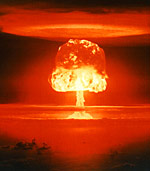
Unit 6: Modern World History
Lesson A: 20th Century Global Politics - The Cold War
Lesson Overview

Nuclear Weapon Test in the Pacific Ocean on Bikini Atoll [1]
The tensions that emerged at the end of World War II between the democratic United States and Communist U.S.S.R. were called the Cold War. The Cold War often flared into hot conflicts as regional wars were incorporated into the larger Cold War. Countries in Asia, Europe, Africa, and the Americas chose sides and felt the impact of this conflict. The world was faced with a new threat: a possible third world war between the superpowers and their allies that could include nuclear weapons. When the Cold War finally ended, European communism was defeated, nuclear war was averted, and much of the world entered a new era of economic and political conflicts.
Key Questions
- Why do changes in economic and/or political systems cause cultural change?
- What impact has science, technology, and economics had in shaping regional and global cooperation, conflict, and interdependence?
- How do societies seek security in the world?
Student Outcomes
- Analyze the causes, events, and consequences of the Chinese Revolution, including the roles of Chiang Kai-shek (Jiang Jieshi) and Mao Zedong and the creation of Taiwan.
- Compare the Chinese Communist System with that in the Soviet Union.
- Explain how regional wars, conflicts, and nationalistic movements, such as those found in Korea, Vietnam, Cambodia, Cuba, Angola, El Salvador, Nicaragua, Israel, and Afghanistan were incorporated into the larger Cold War.
- Describe the role of significant individuals in the decline of the Soviet power throughout Eastern Europe, such as Lech Walesa, Vaclav Haval, and Aleksander Solzhenitsyn.
- Examine how the internal policies of Mikhail Gorbachev led to the end of the Soviet Empire and Soviet Union.
- Examine the series of events that resulted in increased pressure on the Soviet Empire, such as the expense of the arms race, the unpopularity of the Afghanistan War, the election of Solidarity in Poland, and the fall of the Berlin Wall.
- Evaluate the implementation of a decision. (Historical Thinking Skill)
Key Terms
- capitalism
- containment
- dissident
- domino theory
- labor strike
- Prague Spring
- proxy war
- satellite countries
- Solidarity Movement
- Velvet Revolution
Student Resources
- Battles of the Cold War Jigsaw Fact Sheets (pdf)
- Battles of the Cold War Jigsaw Graphic Organizer (doc)
- China and Its Neighbors (doc)
- Fall of the Soviet Empire (doc)
- Decline of Communism Brief Constructed Response (BCR) (doc)
Chart of Activities
| Activities to Complete | Estimated Time |
|---|---|
| Key Terms | 5 minutes |
| Pre-Assessment | 5 minutes |
| Activator: The World 1945-Present | 5 minutes |
| Opening: Capitalism and Communism | 10 minutes |
| Activity 1: China and the Cold War | 10 minutes |
| Activity 2: Comparing China and the Soviet Union | 10 minutes |
| Activity 3: The Cold War Expands Regional Conflicts Jigsaw | 60 minutes |
| Activity 4: Overview - China as a Player in the Cold War | 10 minutes |
| Activity 5: Labor's Opportunity | 15 minutes |
| Activity 6: Fall of the Soviet Empire | 15 minutes |
| Review and Assessment | 25 minutes |
| Lesson Summary | 5 minutes |
Lesson Completion Time
The total estimated time to complete this lesson is 175 minutes.
Page Notes:
[1] Source: This image from http://en.wikipedia.org/wiki/File:Mushcloud.jpg is a work of an employee of the U.S. federal government and therefore is in the public domain.

